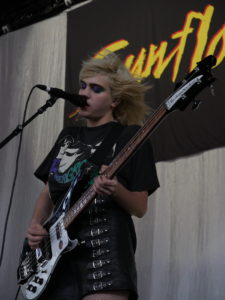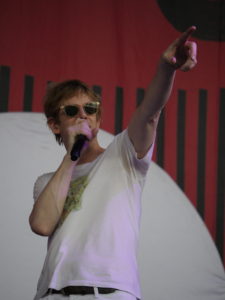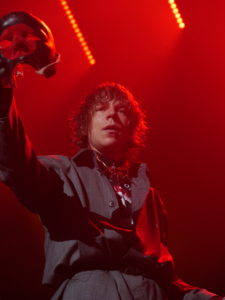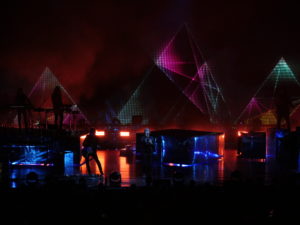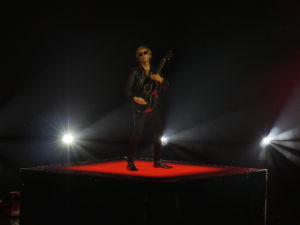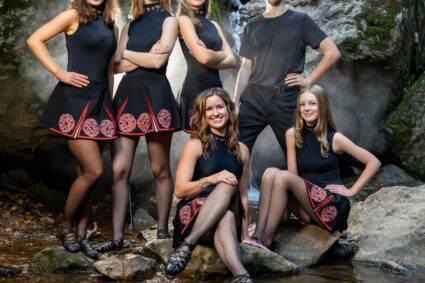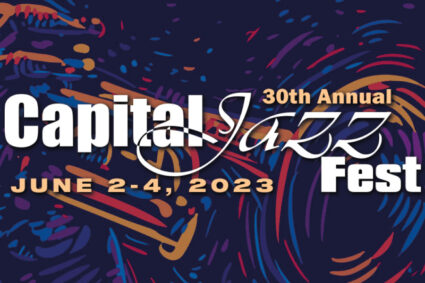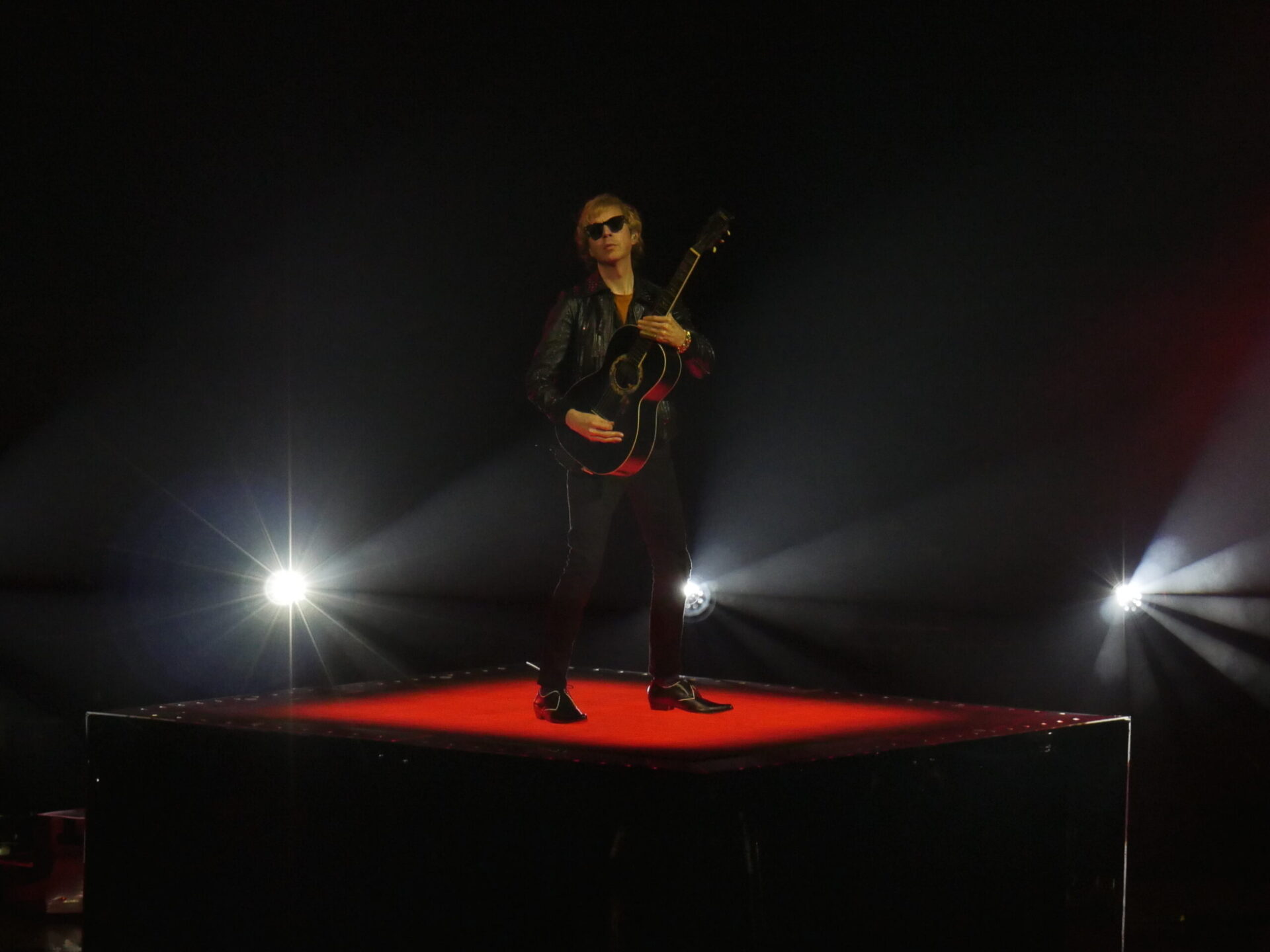
On a beautiful, sunny summer day in August, Merriweather Post Pavilion in Columbia, MD was abuzz in anticipation of a truly jam-packed lineup featuring rock acts spanning the decades. So jam-packed, in fact, that the show bucked convention in bumping up the typical weekday venue showtime by an hour-and-a-half.
From timeless veteran artists such as Beck and Spoon, whose careers date back thirty and twenty-six years, respectively, to Cage the Elephant, who have firmly established themselves on the music scene with an equally impressive repertoire in under half the time, to relative newcomer and presumptive unknown to most in attendance, Sunflower Bean, seeking to state their case for relevance to the early arrivers, the show was bound to produce some unforgettable memories.
Eagerly taking the stage first was Sunflower Bean, so much so that they began playing two minutes before their announced 6 pm set time. If jumping the gun was a sign of any early jitters, the band declined to give any further indication as they came out strong with a gut-punch of a guitar riff, the lead-in to the sneakily catchy King of the Dudes. As they slowed things down for their next few songs, the notable grungy flair in lead singer Julia Cumming’s voice, which powered their opener, turned unexpectedly soft, almost folksy, demonstrating her impressive vocal versatility.
After expressing how they wished they were out on the lawn with the masses—a sentiment they would likely reconsider a few hours later—the singer acknowledged the “Baltimore” crowd, dedicating their next song, I Was Home, to John Waters. The centerpiece of the group up until this point, Cumming took more of a back seat for this one. Highlighted by the inspired guitar playing of Nick Kivlen, the song soared on the wings of a phenomenal bridge worthy of a true rock anthem.
The band concluded by urging the crowd to get out of their seats for their last song, Come for Me, saying, “6:20, I don’t care what time it is.” Featuring a funky rhythm and an aggressive chorus, asking “Do you really want to come for me?” the band demonstrated with their tight six-song set not only that they could hold their own, but that they were far from intimidated by the lineup to follow.
After a quick turnaround, it was Spoon’s turn to step up to the plate. Despite experiencing technical difficulties with the bass for their first two songs, fittingly, they righted the ship with their 2002 hit The Way We Get By. Lead vocalist and guitarist Britt Daniel, whose distinctive raspy voice never ceases to send chills down the spine, confidently powered through the band’s early struggles with his swagger, engaging the crowd with his cross-stage dance-playing and by dropping to his knees in a fit of passion twice within the band’s first four songs. The essence of cool, he effortlessly pulled off a bad boy Elvis routine in his fashionable sunglasses and an all-white getup of jeans, a graphic tee, and matching white guitar.
The band then hit their stride, stringing together a solid five-song stretch, beginning with The Underdog, whose theme was so powerfully cheery it felt like it could summon the sun on command. But just as quickly as they built the crowd up, they swiftly knocked them back down with a melancholic John Lennon cover, Isolation, a song that thematically would mesh seamlessly with those to follow from Cage the Elephant’s latest, markedly introspective album. Returning to crowd favorites, I Turn My Camera On, Don’t You Evah, and Do You, extended jam sessions accentuated the band’s unified sound as no single instrument was swallowed up or neglected, all contributing equally in perfect balance. It was truly a delight for the ears.
The band rounded out their set with Inside Out and Rent I Pay, the former defined by a trippy, haunting, synth solo by Gerardo Larios. The weight of the melody breathed life into the band’s backdrop, which despite its simple design, achieved depth with a vertical black line pattern that protruded beyond its 2-D surface, encircling a white orb positioned between the two planes like a ring around a planet. The eye was drawn to its center much like the crowd was sucked into the band’s sound by an invisible gravitational pull, the residual effect leaving everyone in a trance well beyond the last note played.
Admittedly, I was unprepared for what came next. If any lingering spell over the crowd persisted, it was unsentimentally obliterated by Cage the Elephant’s opening song, Broken Boy. The band came out hot, literally and figuratively, with flames lining the length of their set, the heat radiating outward, toasting the first few rows. Their energy was overwhelming, enthralling, infectious, taking the crowd by storm as an actual storm brewed ominously on the horizon. The pavilion-area was instantly ignited in dance and headbanging. Fog machines and strobe lights disoriented the senses, offering only faint glimpses of the already obscured singer, Matt Shultz. Shrouded in mystery, he began the show in all black, his face concealed by a veil. Eerily holding the metal skeleton of an open umbrella before hastily ditching the prop into the mass of people in front of him upon the song’s first forceful note, Shultz ripped his microphone from its stand, later brandishing the discarded pole like a spear before tossing it to the ground on beat with a thud.
Pulling back the veil at the song’s conclusion, the first of dozens of costume changes, a gradual disrobing over the course of their hour-long set, Shultz revealed a demonic black and red masquerade mask. Accessorizing on-and-off throughout the night with a rotating selection of hats, the singer teased the crowd by partially removing the disguise several times before finally taking it off for good—mostly—following the third song, Spiderhead, holding it high in the air as he stared down the pit in an “Are you not entertained?” kind of boast. The crowd came for a show and Shultz was intent to deliver.
As the show continued through familiar tunes such as “Too Late to Say Goodbye,” during which Shultz flung his hand back and forth through the open flames onstage, and “Cold Cold Cold,” the band increasingly began to explore their performance space. Lead guitarist Nick Bockrath, especially, could be seen making use of the bleacher-like set, taking a seat on its back row, reminiscent of a lunch period jam session at a high school sports field. By now, the singer, who continued to flutter back and forth across the stage, had stripped down several more layers, at one point sporting a single black glove, recalling memories of Michael Jackson, especially when paired with a display of suave dance moves.
The band then circled back to their new album with Ready to Let Go and Social Cues, the former foreshadowing their impending directive to relinquish the stage as Shultz soon confirmed the ever-nearing lightning would force an imminent evacuation. Perhaps fazed by the announcement, the final song before the unscheduled break seemingly caught the band off-guard as an apparent discord between the lead and backup vocals drew out the song’s intro another couple measures. Shultz’s showmanship would come to the rescue, however, temporarily quelling the air of nervousness hovering over the crowd. Now in an orange collared shirt, matching red-orange tie with black stripes, and still sporting a wide-brimmed hat, Shultz staggered around the stage like a possessed scarecrow, mixing in the occasional Mick Jagger-like strut. Covering his long, sweat-soaked hair one last time with his hat, Shultz briefly took a seat in solidarity with the crowd before ultimately yielding the microphone to the venue’s staff.
Upon the band’s temporary exit at 8:30, those safely under the pavilion erupted in relief at the news that they would only be required to shelter in place while the not-so-lucky lawn groaned in horror as they were banished to their cars for the next 45 minutes, a mandate that would have been more easily stomached had the timing of the evacuation not been so regrettably late, forcing people to embark on the perilous trek just as the worst part of the storm was beginning to pass through. Most of them likely failed to make it safely before the torrential rain and 60mph wind gusts descended on the area.
By 9:05, the crowd resorted to doing the wave in an attempt to keep spirits high. Ten restless minutes after the designated return time, the show was finally back on. And miraculously, Cage the Elephant picked up right where they left off with Don’t Mess Around, letting the crowd know they were back and they meant business, wasting no time getting them on their feet again and clapping to the beat. Kudos to the band for maintaining that level of intensity and not letting the weather cool them down, no small feat after an almost hour-long break very near the middle of their set.
After coasting through two more crowd favorites in Trouble and Ain’t No Rest for the Wicked, much in the way a professional cyclist masterfully saves his energy down a steep descent—I should mention at this point Shultz is now in full spandex, sporting a white cycling jersey and shorts—the band awed with another new song, “House of Glass.” Red sparks fired from the ceiling for the chorus and white flames climbed skyward for the bridge, punctuated by a dramatic dive to his knees by Shultz as he fully surrendered his body to the stage. The crowd would find out later amongst the continued disrobing that he was wearing kneepads—safety first!
The next two songs, Cigarette Daydream and Shake Me Down, particularly resonated with the crowd in the context of the weather, especially the lines “You can drive all night looking for the answers in the pouring rain” and “I’m like rolling thunder/even on a cloudy day, ” the latter triggering white smoke that engulfed the stage, clearing only for the last few words of the song to reveal the singer in a fencing mask.
The set concluded with Come a Little Closer and Teeth, pulling out all the stops with effects from fog to fireballs. By the end, the singer wore nothing but red athletic shorts and socks over a nude body stocking, a red strip of tape dissecting the middle of his chest. He leaped around the stage, attempted something approximating a headstand, then climbed down into the pit where he finished their final song, chucking his microphone back onstage at its close in his own unique twist on a mic drop. That alone would have made for an epic farewell, but Shultz had more in mind. The music transitioned to Queen’s We Are the Champions, and like a heavyweight title winner raising his fists in triumph after a knockout, he continued to scale the pavilion right down the middle, hurdling seat after seat, person after person, cutting through the sound booth, all the way back to the lawn; a five-minute-long victory lap declaring their rock supremacy, few would dare challenge their claim with a curtain call like that.
I could not think of a more perfect way to end the night. Unfortunately, there was still one more act to play, and he now had to follow the unfollowable; it was impossible for Beck’s performance not to feel tame in comparison. Not helping matters was his tardiness. Showing up a good fifteen minutes late—I generously rounded down—despite his already belated set time due to the weather delay and the strict noise curfew at the venue looming in the near future, it was easy to feel frustrated and shortchanged by the artist. An already shortened set would become even shorter, and for what, mystique? To his credit, he would later play into borrowed time and then some, but overall it was a missed opportunity for more music from a rock icon many in attendance had come specifically to see.
Beck did his best to make up for it, however, diving headfirst into his set with quarter-century-old megahit, Loser. It speaks to the sheer depth of his catalog and to the degree of his recent success that he could play by far his most popular song first and still have plenty left in the tank. In all black from head to toe, looking like the stereotypical rebel Cool Kid in his studded leather jacket and sunglasses, he sure knew how to make an entrance. Strumming a bluesy tune, a black acoustic guitar complimenting his outfit, he stood alone upon a black cube, illuminated from below by red lighting, evocative of a red carpet entrance. The glasses and guitar would not last, though, as he descended from his lofty perch to join the band right as the familiar tune began.
The singer would follow up his inaugural song with Up All Night, asking the crowd, “Should we stay up all night together?” a question that rang hollow given the aforementioned lateness and time constraints. Nevertheless, the song’s joyful sound, along with that of the ensuing Girl, would break the tension. It would also signal the growing emphasis on background visuals, as Beck once again climbed his cube to perform in front of several stories tall, an impressionistic neon depiction of his live self. The scope of the graphics would later range from fun notebook margin doodle animations to surrealist collages to visualizations of constellation-like patterns mapped onto the performers, heightening the already trippy nature of a large swath of the artist’s music.
Beck then picked up a guitar again for Mixed Business and an oddly semi-spoken word version of Debra, which he concluded by getting the crowd to sing the song’s repeated final lines back to him acapella while he turned his attention toward preparing for the next song. Devoid of any instruction by the singer or the band, the awkward experiment left so many unsure of when to stop singing that the lighting crew tried mercifully to put them out of their misery by dimming the stage lights. It took a moment, but the message was received—eventually.
Holstering his guitar once more, Beck forged ahead with “Wow,” swinging his microphone like a lasso to the lyric “Giddy up!” as a western backdrop periodically peered over his shoulder, the overall scene coupled with the earlier edition of his black wide-brimmed hat, now lending comparisons to Westworld’s Man in Black. He then jokingly promised not to “summon the lightning” with the playing of his latest release, Saw Lightning, a flippant quip that seemed perhaps a little too soon for the still triggered crowd.
Following a solid performance of Dreams, the singer claimed he was only just told about the “really strict curfew,” regretfully expressing how “we’d like to stay longer, but we’re gonna try to fit as much as we can in.” While hard to believe no one would have addressed the issue with him sooner, the sentiment came across as especially genuine since, as if spurred by the news, he promptly delivered the most inspired stretch of his set yet.
Returning to his early rock roots once more, he instantly elevated the energy in the room with a fast-paced Devils Haircut, then “snuck in” an abbreviated, stripped-down version of Lost Cause that was so heartfelt and raw, it’s a shame it only lasted about a minute due to the time restrictions. Wrapping up his set with high-powered “E-Pro,” Beck moved about the stage unrestricted as if declaring himself free from the isolation of his oversized personal cube of a stage upon a stage. Besides heaps of heart, the song would encompass everything from a recurring Wilhelm scream during the chorus, to Beck shredding, to the release of an array of massive balloons in grayscale tones, tumbling down the pavilion crowd toward the stage, drawing a standing ovation as the artist made his exit.
But lucky for those who had endured the long night, the show was not yet over, though Beck’s scheduled set duration officially was. Returning for an encore with Where It’s At?, the singer had transformed his look in the interim, unveiling an all-beige and white suit and hat pairing as if to usher the crowd through the pearly gates into the afterlife of his set. Galloping around the stage, he paused intermittently to play with the balloons that had accumulated around him, casting echoes of Bill Clinton’s display of child-like merriment during the 2016 Democratic National Convention. Even the band got in on the fun as guitarist Jason Falkner claimed and bounced gleefully atop his own balloon.
Beck would throw in an abridged, up-tempo harmonica blues ballad in One Foot in the Grave before saying his final goodbye with the help of some of the previous acts. Inviting Spoon’s Britt Daniel back to the stage, the pair performed a perfect cover of Elvis Costello’s Pump It Up with Daniel taking the lead and Beck providing a combo of backup vocals and dance moves. Daniel, now sporting a white leather jacket on top of his already white ensemble, would then switch to the guitar as Beck invited Cage the Elephant’s Matt Shultz to join him in performing their recently released collaborative duet, “Night Running,” the tour’s namesake. Having restored some of his former costume, Shultz reappeared in his all-white athletic wear, accessorized by a beige suit jacket and his fencing mask. Still shedding layers like a nesting doll, Shultz would remove the mask to reveal a smaller white masquerade mask, tucked beneath a white bucket hat and sunglasses. As the duo played off of each other’s energy, trading verses and mirroring dance moves, the song’s reggae-style wholly hit home the dream-like sight of the night’s trio of male leads uniformly dressed like heavenly beings.
Reprising “Where It’s At” for the final performance of the night, confetti showering down from overhead, the performers celebrated the occasion with a five-minute-long musical breakdown, a dance line forming at the front of the stage. As the song came to a close, it was only fitting that the encore end how it began, continuing its fantasy vibe. Hands clasped together in the air, Beck and Shultz took a bow before executing a slow, crab-like sideways scuttle off the stage, leaving the boisterous crowd wonderstruck. Five-and-a-half long hours after the night’s journey began, a satisfied crowd trickled out of the venue for their vehicles. At least one person could be heard blasting Beck from their car stereo, a telltale sign after any successful concert—that the fans’ appetite for the bands they love and the music they came to experience would never be satiated.
FINAL GRADE: A-
